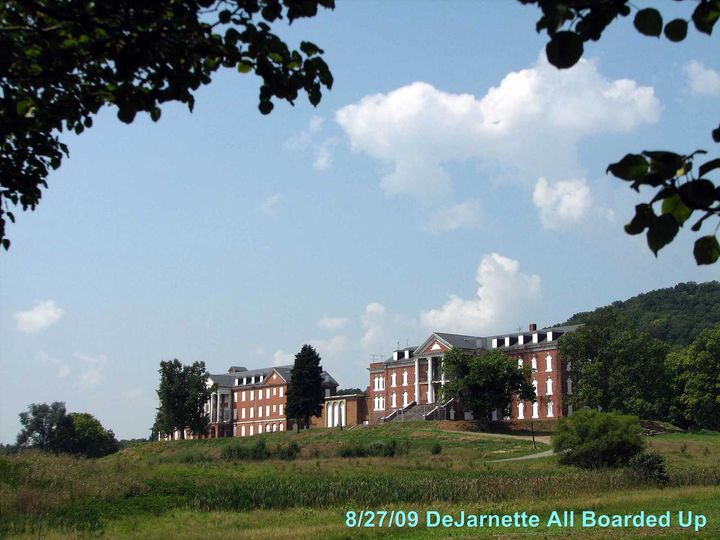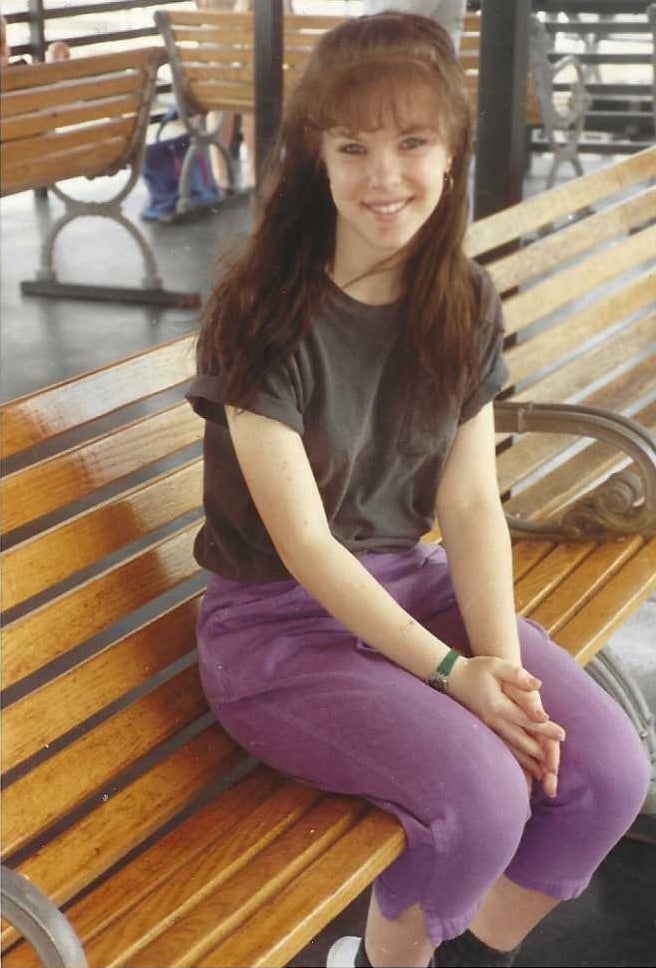
When I go down the internet rabbit hole of my past, I don’t look up exes or the girls who bullied me in eighth grade. I look instead for things that really hurt: the group home I was in during my junior year of high school that’s now someone’s house; the residential campus near the beach that closed in an abuse scandal; and DeJarnette, the state-run children’s institution that’s now listed as the most haunted asylum in Virginia.
I lived in DeJarnette as a stop-over when I was 14, relatively new to the foster care system, and waiting for a bed to open up at a long-term facility. A quick search for DeJarnette pulls up scores of ghost hunter-type videos showing the usual fare: brave explorers with flashlights and ghost-tracking equipment entering a looming, abandoned brick building.
The white, two-story columns on the front almost seem to glow in the dark. The rows of windows flanking the entrance are boarded up, giving the facade an eerie appearance. Inside, someone insists they saw a shadow move. Someone else calls out that they felt a cold draft. If you’ve watched one haunted nighttime urban exploration video, you’ve seen them all.
The difference is that I walked those halls. I recognize the once-grand arches that frame the doorways. When the adventurers get to the corridor with the bedrooms, and sweep their flashlights along the graffitied walls, I always wonder which one was mine.
The facility, originally known as the DeJarnette State Sanitarium, was founded in 1932 by Dr. Joseph DeJarnette. He’d been in the sanitarium business since 1906, previously managing a colony for people with epilepsy and those he referred to as feebleminded. In the 1920s, he petitioned Virginia’s state government to pass a law allowing compulsory sterilization. His lobbying worked. He targeted those he called “defectives” and the “feeble-minded.”
In addition to people of color, he forcibly sterilized single mothers, alcoholics, those with mental conditions and epilepsy, the poor, and the incarcerated. He was reported to have close ties to Hitler and the Nazis. By 1938, it was said that, at his urging, the United States had sterilized over 27,000 people.
He was ousted from the center in the early 1940s. The building was converted into a children’s mental hospital in 1975 when Virginia took over.
Dr. Joe’s evil spirit is said to walk the halls. Some say they’ve heard children’s voices in the darkness or moans and other noises from the former patients reported to have perished due to medical experiments.
I doubt the teens who once lived there were aware of Dr. DeJarnette by name. I wasn’t. However, the building’s ties to eugenics were among the first things new kids learned about the center.
“Why did they do it?” I asked the girl assigned to show me around on my first day after she’d filled me in on the building’s history.
“They think your kids are gonna end up like you,” she said. “If we don’t have babies, they’ll be less of us and more of them.” I wasn’t totally sure what more of them meant, but I understood less of us. Less of me.
Despite DeJarnette having an imposing presence and a horrifying history, few memories of my time there match the building’s ghostly reputation.
Once a week, we made sandwiches to sell to the staff. I learned to cook bacon for the BLTs that were on the menu. I was clumsy in the kitchen; I left home at 13 and hadn’t cooked much for myself except microwaveable foods and things I could graze on. A DeJarnette counselor showed me how to get the flames on a gas stove exactly right and what to look for when bacon is fully cooked.
Sandwiches were made assembly-line style, with each kid doing a single job dozens of times. The week I was on mayonnaise duty, I learned that you should spread condiments to the edges of the bread. I looked at the slice in my hand. The mayo was an uneven glob. I spread it evenly and proudly fixed all the inadequate slices.
I lived in DeJarnette during the winter. The holidays were approaching. It was my first Christmas in the system. I was learning the ropes, yet I was still hopeful for Christmas presents, even if I wasn’t sure where they would come from.
A woman from a local church came to collect our Christmas wish lists.
“You can get anything you want, as long as it’s less than 10 dollars,” she told us.
My expectations were perpetually low back then. I fixated on the phrase anything you want. There were endless possibilities at that price point. I’d started shoplifting shortly before I left home. I was well aware of the multitudes of things for less than 10 dollars that one can easily slip into a baggy pants pocket. However, I asked for a Def Leppard tape, thinking of the luxury. Tapes were difficult to shoplift. All mine had been left behind. I failed to consider that I no longer had my boom box either.
We celebrated Christmas in the dayroom after lunch. I was thrilled to receive my tape, despite not having a way to listen to it. I knew I would leave DeJarnette as soon as my social worker found a long-term arrangement for me. The tape symbolized hope and the belief that someday, I would have a tape player again.

I don’t have children. I never wanted them, even when I was younger. However, there is a wide gulf between choosing not to have children and someone taking the choice away from you.
Even as society began to condemn Dr. Joe’s ideology, he was a vocal proponent of the practice until he died in 1957. The United States was changing, and by the late 70s, eugenics was considered discriminatory and offensive. Despite progressive attitudes, Virginia continued compulsory sterilization until 1979.
Eugenics allowed a stranger to decide what kind of person you were and what side of more of them and less of us you fell on. Most of us will agree this is an offensive, abhorrent concept. We like to believe we’ve progressed beyond beliefs like that. Yet the fight for reproductive freedom continues today.
October can be a spooky month. A few nights ago, I made a mug of tea and settled onto my couch to watch DeJarnette’s latest ghost chaser videos. I didn’t mind indulging in the rabbit hole as Halloween is approaching. But I’d never go there after dark. I’m not afraid of the spirits of lost children, Dr. Joe’s many victims, and even Dr. Joe himself, who all roam the halls, according to the videos. Instead, I’m afraid of stepping on a nail or cutting myself on rusty metal. At my age, I’m worried about more practical things.
In the world of social services custody, certain places focus on kids who will age out of the system rather than ever going home. I was one of those kids. I left DeJarnette in the spring when a bed opened up for me at a long-term residential center.
I don’t have typical teenage memories of homecoming dances, first dates, sweet 16, or getting a driver’s license. I like to think I have something better; I made it through the system and didn’t become a statistic. I’m thriving today, and that’s worth far more than the girl I was back then would have asked for.
Some people believe decades of past experiences and emotions can leave residual energy in a place. Maybe that’s partly what the ghost hunters are searching for. Because when you consider the collective traumas and experiences of all those who spent time in that cavernous, state-run institution, there was plenty of haunting going on. It wasn’t ghosts, though. It was us.
Do you have a compelling personal story you’d like to see published on HuffPost? Find out what we’re looking for here, and send us a pitch.
